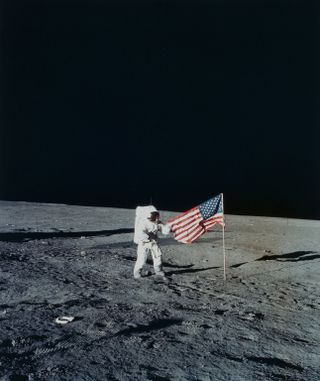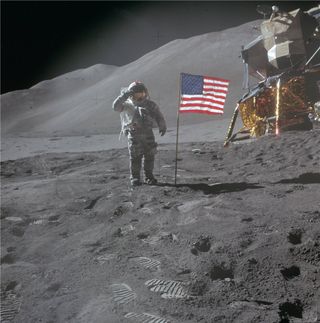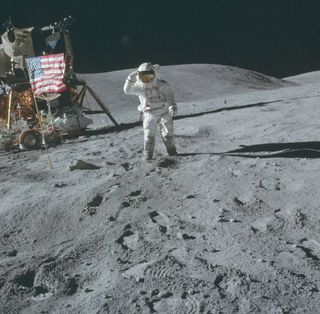Fifty-five years ago today, the Apollo 11 flag raising on the ancient lunar surface lasted just 10 minutes during Neil Armstrong and Buzz Aldrin’s two-and-a-half-hour lunar adventure in July 1969.
But this founding event in vexillological history was not without giving rise to many debates, discussions and early concerns about the question of “who owns the Moon?” (Vexillology is the study of the history, symbolism and use of flags).
Matthew Ward is a lecturer in history at the University of Dundee in Scotland. He points out that the American flag is particularly powerful and seems to be present in the imagery of almost every key event in American history, from the Apollo moon landings to firefighters raising the flag over the ruins of the World Trade Center on September 11, 2001. “It’s hard to think of another flag that is as loaded with meaning. The American flag expresses the spirit, history, and identity of an entire nation,” Ward says.
Symbolic activity
In the early 1990s, Anne Platoff, then working at Hernandez Engineering Inc. in Houston, Texas, wrote a report for a NASA contractor titled “Where No Flag Has Gone Before: Political and Technical Aspects of Placing a Flag on the Moon.”
Platoff explains that the Apollo 11 flag-raising on the Moon was a purely symbolic activity. Since the United States was a signatory to the United Nations Outer Space Treaty, signing that treaty precluded any territorial claims to the Moon.
“There was, however, national and international debate about the appropriateness of the event,” Platoff said. Congress amended NASA’s appropriations bill to prevent the space agency from flying the flags of other nations or international associations on the moon during missions funded solely by the United States.
Platoff notes in his report that the legal status of the Moon would clearly not be affected by the presence of an American flag on the lunar surface, “but NASA was aware of the international controversy that could result.”

Flagpole Design
In his report, Platoff points out that raising the Apollo flag also posed technical challenges for NASA engineers.
“They designed a pole with a horizontal bar that would allow the flag to ‘float’ without the aid of wind to overcome the effects of the moon’s lack of atmosphere. Other factors considered in the design were weight, heat resistance, and ease of assembly by astronauts whose spacesuits limited their range of motion and ability to grasp objects,” Platoff explains.
Apollo 11’s Buzz Aldrin later recounted in an article written for Life According to the magazine, as he looked at the flag, the moonwalker felt an “almost mystical unification of all the people of the world at that moment.”
Aldrin also described what it was like when he and Armstrong were able to install the flag, a pennant purchased locally in Houston for $5.50.
“Just below the powdery surface, the subsoil was very dense,” Aldrin recalled. “We managed to sink the flagpole only a few inches. It didn’t look very solid.”

Sun rot
In his research, Platoff discovered that the six flags placed on the Moon by the Apollo astronauts were not all the same size.
Additionally, the Apollo 17 flag planted in December 1972, the program’s final lunar mission, was particularly notable; this flag had been displayed in the Mission Operations Control room during the other Apollo missions and then placed on the Moon by the last crew to walk on the Moon, Eugene Cernan and Jack Schmitt.
What is not known is the current condition of these flags. Even if they remained upright when crews launched from the Moon, it is almost certain that they are not in the same condition as when they were first deployed on the lunar surface. “It is highly likely that the nylon of the flag has degraded from prolonged exposure to sunlight,” Platoff says, a destructive result referred to as “solar rot.”
The lunar flags likely became brittle and may have disintegrated over time. Another threat to lunar flags is bombardment by meteorite impacts similar to those on the Moon, Platoff concludes.
Platoff is now a librarian, historian, and vexillologist at the University of California, Santa Barbara.
“One thing I keep seeing in articles is that flags would bleach from exposure to sunlight. While that does happen to some flags on Earth, I’m not sure what the chemical process is and I don’t know if it would happen in a lunar environment,” Platoff told Space.com.

Research: critical thinking
As Platoff writes in his 2011 research paper, “Six Flags on the Moon: The Role of Flags in Moon Landing Conspiracy Theories,” whether the flags remained standing or withstood decades of exposure to the harsh lunar environment, “their legacy as a symbol of human space exploration remains intact.”
Clearly, the importance of these images, Platoff said, “will endure long after the deaths of those who participated in this historic enterprise.”
As for those who support the Apollo moon landing conspiracy, Platoff is adamant on the issue.
“It’s not hard to debunk conspiracy theories about the moon landings,” Platoff told Space.com. “There’s plenty of evidence that the Apollo landings were real and that humans walked on the lunar surface.”
The real problem, Platoff adds, is that people need to be taught to develop critical thinking skills.

“Do you really think it would be possible to maintain the level of cooperation of all the players in the Apollo program to keep the hoax going for fifty-five years? Or is it more plausible that people working together could have harnessed the power of science and technology to achieve the goal of sending astronauts to the moon and returning them safely?”
People who deny that the Apollo moon landings happened, Platoff concludes, “are free to believe whatever they want, but that doesn’t make them right.”